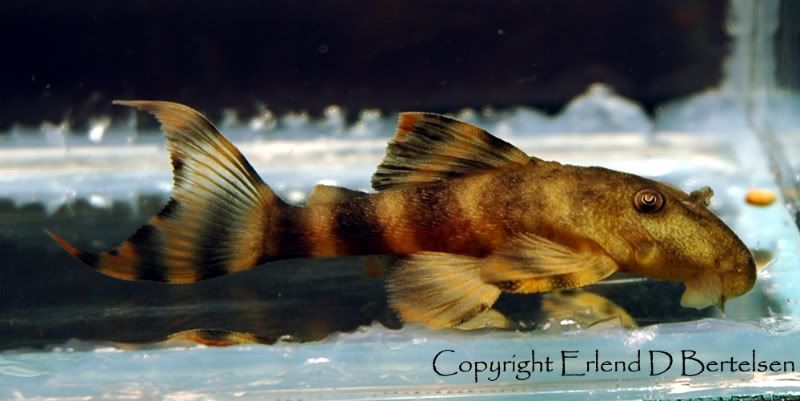







Oh thanks for that. Although Panaque changae has also been suggested to me but that has a striped tail.racoll wrote:I've seen a fair few of these and I would definitely say he is , and a nice one too...
and are very similar. It might be worth getting another close-up of the tail to make sure it is spotted rather than broken striped.Oh thanks for that. Although Panaque changae has also been suggested to me but that has a striped tail.
As indigoj said, wood and veggies are what he needs. I feed my with soft birch wood, broad beans and algae wafers, and they are very hairy!!If it is an L206, do you any info on their diets as there's nothing on the PC page.
I happen to have the description of P. changae in front of me, and there in no mention in either text or photograph of a spotted caudal fin.I would say this is P.Changea, because of the pattern on the head. The L-206 has both stripes and spots in the caudal fin. The L-206 grows only to about 8 cm, but the P.Changea reach 12cm. The P.Changea has a pinkish shine in the fins.



Where do you get the birch wood? I don't have broad beans, would peas do? ;)racoll wrote:soft birch wood, broad beans and algae wafers, and they are very hairy!!
Well my one looks most like that second photo. He flared out his caudal fin earlier and it's definitely spotted and he also has the lyretail fin extensions. No pink tints to his fins so don't think it is the P. changae then. The only thing that's still niggling is that, if you compare the photos of my one, it has more numerous and thinner body stripes than the L206...Erlend D Bertelsen wrote:L-206 with spots in the caudal fin.
Telling the difference between spots and broken stripes isn't easy. Try to get a good photo of the tail Trillian.L-206 with stripes in the caudal fin.
I actually collected the silver birch from the Queen's estate at Sandringham. Don't tell her....Where do you get the birch wood?
I don't see why not, but it might be a bit easier for the Panaque to get their teeth into something larger.....I don't have broad beans, would peas do?
I don't necessarily disagree, but how did you reach this diagnosis Yann?Yes this is Panaque changae without much doubt on it!!
You sure? My plec has a spotted lyretail - he flared it out the other night so I got a clear view but alas! too slow to photograph it - whereas P. changae has a striped normal tail. I'm far from an expert but the more photos of L206 that I see, the more I'm inclined to agree that's what I have.Yann wrote:Yes this is Panaque changae without much doubt on it!!